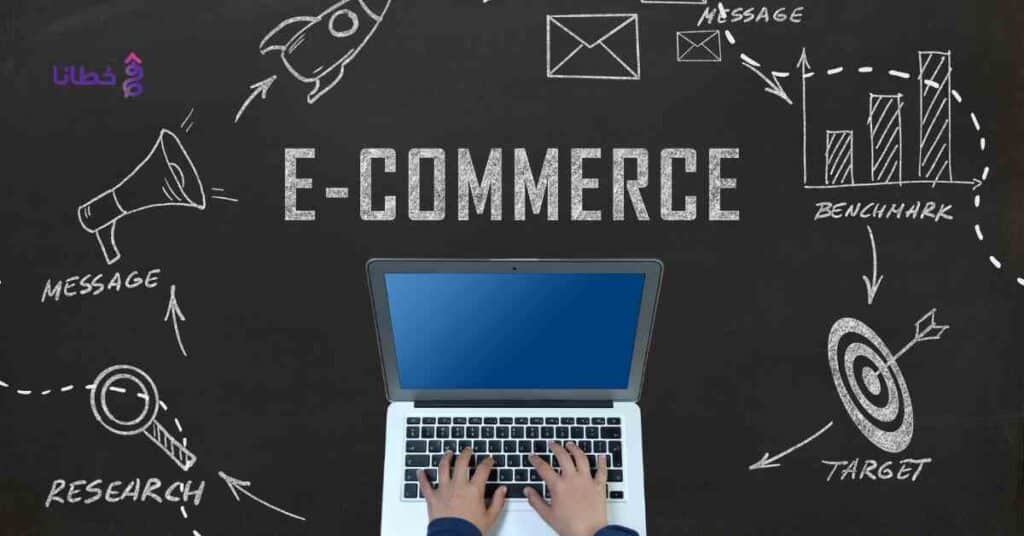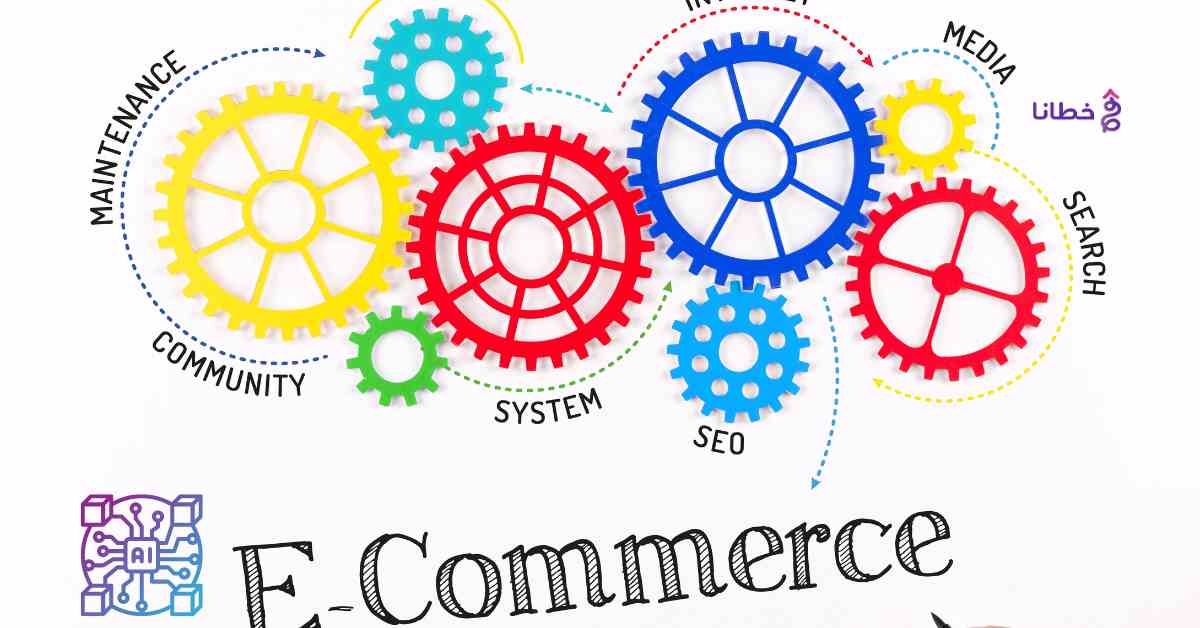table of contents
E-commerce is the backbone of the modern economy, and e-commerce technologies are constantly evolving. The success of online stores depends on a set of advanced technologies that help improve the user experience and enhance sales and purchases. In this article, we’ll review the most important technologies used in e-commerce.
E-commerce technologies used
There are many important technologies used in the field of e-commerce, the most important of which are the following:
1- User Interfaces
- Use techniques such as responsive design to ensure support for different devices.
- Design user-friendly and visually appealing interfaces to enhance the online shopping experience.
2- Data Analytics and Artificial Intelligence:
- Analyzing user data and behaviors for personalized recommendations and targeted marketing.
- Using artificial intelligence to improve demand forecasting and inventory management.
3- Electronic payment systems:
- Developing secure and fast payment systems such as credit cards and digital payment services.
- Support various payment methods to meet customer needs.
4- Smart supply chain:
- Use of Internet of Things (IoT) technologies and real-time shipment tracking.
- Application of robots and advanced mechanisms in distribution centers.
5- Digital Marketing:
- Use social media and digital content to promote and engage with customers.
- Applying visual programming and multimedia techniques to enhance user experience.
6- Security and privacy:
- Applying encryption and data protection techniques to ensure the security of transactions and data.
- Compliance with regulations and standards for the protection of personal data.
These are some of the key technologies used in the e-commerce industry that have contributed to the development of this field and improved user experience and operational efficiency.
One of the e-commerce techniques used in the process of monitoring goods
One common technology used in e-commerce merchandise management is shipment tracking. This technology allows merchants and customers to track the location and status of a shipment throughout its journey from the warehouse to the customer’s address. Shipment tracking works by attaching a tracking code or tag to the shipment. Technology such as barcodes or RFID chips is used to store and identify shipment information. At each step of the shipping process, the shipment code is read and its status is updated in the e-commerce system. This system helps merchants track the movement of goods and their arrival times, and provides customers with transparency and clarity about the location and status of their orders throughout the shipping journey. This improves the customer experience and builds trust in the e-commerce process.
Supply Chain Management (SCM) is one of the e-commerce technologies of 2025
Supply chain management (SCM) is an important aspect of e-commerce. It encompasses all activities and processes associated with the flow of goods and information from the source to the final consumer. SCM aims to improve the effectiveness and efficiency of this process. Some key aspects of e-commerce supply chain management include:
- Digital integration: Using technological solutions to connect different processes and parties in the supply chain.
- Warehousing and Distribution: Optimize storage and shipping operations to reach customers as quickly as possible.
- Continuous Improvement: Analyzing data and implementing continuous improvements to supply chain processes.
- Planning and Forecasting: Using data and analytics to anticipate and prepare for product demand.
- Inventory Management: Control inventory levels and optimize merchandise turnover to efficiently fulfill orders.
- Tracking and Transparency: Provide customers with the ability to track shipments and order status.
Effective supply chain management helps meet customer expectations and improve efficiency and profitability in e-commerce.
The role of advanced technology in improving supply chain management
Advanced technology plays a significant role in improving e-commerce supply chain operations. Some examples include:
1- Big Data Analytics:
- Using big data from multiple sources to analyze and forecast demand.
- Forecast demand and trends for effective inventory and transportation planning.
2- Internet of Things (IoT):
- Install sensors on products and trucks to track location and condition in real time.
- Improve inventory management, shipping and delivery scheduling.
3- Artificial Intelligence and Machine Learning:
- Using algorithms to optimize storage and distribution operations.
- Forecast demand and optimize production and supply plans.
4- Cloud Technology:
- Providing common platforms for data storage and coordination of supply chain operations.
- Accessibility and sharing of information between all parties.
5- Advanced robots and mechanisms:
- Improve warehousing, assembly, packaging and shipping processes.
- Increase efficiency and productivity and reduce human errors.
These advanced technologies enable better data collection and analysis, smarter decisions, and more accurate and efficient operations in the e-commerce supply chain.
Successful examples of leveraging advanced technology in supply chain management in e-commerce
Many e-commerce companies have leveraged advanced technology to improve their supply chain operations. Here are some specific examples:
1- Amazon:
- Amazon has used artificial intelligence and machine learning technology to improve demand forecasting and inventory management.
- It has invested heavily in robotics technology and advanced mechanisms for warehousing and distribution in retail centers.
- Developed a real-time shipment tracking system using the Internet of Things.
2- Alibaba:
- Alibaba uses artificial intelligence and machine learning to analyze big data to improve demand forecasting and inventory planning.
- Developed an integrated cloud platform to coordinate and track supply chain operations for its trading partners.
- Robotics and automation technology have been used in distribution centers to increase productivity and accuracy.
3- Wayfair:
- Invested in robotics technology to increase the efficiency of warehousing and distribution operations in retail centers.
- Wayfair uses artificial intelligence to improve pricing, promotions, and recommendations for customers.
- Developed an advanced shipment tracking system using the Internet of Things to improve customer experience.
What are the e-commerce techniques according to SEO rules?
1- Responsive online store design:
Responsive web design is one of the most important technologies to adopt in e-commerce. This design ensures that content displays optimally across various user devices, including smartphones, tablets, and desktop computers. This improves the user experience and leads to increased conversion rates.
2- Improve speed:
An online store’s loading speed is a crucial factor in its success. Users can’t stand waiting for pages to load for long periods. Therefore, steps should be taken to improve loading speed, such as compressing images, CSS, and JavaScript files, using a content delivery network (CDN), and choosing fast and reliable hosting.
3- Improving user experience:
User experience (UX) is one of the most important factors affecting the success of an online store. The interface should be easy to use and simple, with content clearly and smoothly organized. Advanced search and product filtering options should also be provided, as well as quick and secure purchases.
4- Security and protection:
Security and protection are among the most important considerations in e-commerce. An online store should include data encryption, secure payment mechanisms, and backup plans to protect customers’ sensitive information.
Search Engine Optimization and E-Commerce:
Search Engine Optimization (SEO) is one of the most important techniques in e-commerce. An online store should include accurate descriptive titles, product descriptions with relevant keywords, an XML sitemap, and relevant internal and external links. These examples illustrate how leading e-commerce companies have leveraged advanced technology to optimize their supply chain operations, resulting in improved efficiency, productivity, and customer service.
Are there any new or emerging technologies in the e-commerce space that you expect to impact this sector shortly?

There are some emerging and new technologies in the field of e-commerce that are expected to significantly impact this sector in the near future, the most important of which are:
1- Cloud Commerce:
- Using cloud infrastructure and services to improve the flexibility and efficiency of e-commerce systems.
- Rapid development and deployment of applications and services via the cloud.
2- Artificial intelligence and advanced machine learning:
- Applying advanced AI models in areas such as demand forecasting and personalized recommendations.
- Using natural language processing techniques to improve user interaction and customer service.
3- Blockchain technology:
- Using blockchain to create secure, encrypted, and transparent payment systems.
- Blockchain application in product tracking and supply chains.
4- Augmented reality and virtual reality:
- Develop engaging shopping experiences using augmented and virtual reality technologies.
- Improve product discovery and purchases with these technologies.
5- Mobile commerce and mobile shopping:
- Use of smartphone applications and digital payment technology.
- Focus on improving the mobile shopping experience.
6- Internet of Things (IoT) in e-commerce:
- Implementing IoT solutions to improve supply chain and inventory operations.
- Connecting smart devices to online shopping experiences.
These emerging technologies will significantly transform the e-commerce industry in the coming years, enabling smarter and more efficient shopping experiences. Khutana can help you achieve your marketing goals.
What are the main benefits these technologies can bring to SMEs?
There are several key benefits that emerging e-commerce technologies can bring to small and medium-sized businesses, most notably:
1- Improving efficiency and productivity:
- Using artificial intelligence to improve forecasting, planning, and inventory management processes.
- Leverage cloud computing to reduce infrastructure and operating costs.
2- Increase competitiveness:
- Developing unique shopping experiences using augmented and virtual reality technologies.
- Reach a wider customer base through e-commerce.
3- Improving customer service:
- Leveraging AI systems to provide immediate and interactive customer support.
- Create secure and easy-to-use payments using blockchain.
4- Enhancing transparency and traceability:
- Connect smart devices to your e-commerce system for increased visibility and control.
- Using blockchain to improve supply chain transparency and traceability.
5- Access to new markets:
- Access to new customers around the world through e-commerce.
- Use smartphone apps to boost your reach to local customers.
These technologies will enable small and medium-sized businesses to leverage the benefits of e-commerce, improve their competitiveness in the market, and provide a better shopping experience for their customers.
How can small and medium-sized enterprises (SMEs) benefit from blockchain technologies in their business operations?
There are several ways small and medium-sized businesses can benefit from blockchain technologies in their business operations, including:
1- Supply chain tracking:
- Using blockchain to track products and raw materials across the supply chain.
- Providing transparency, accountability, and improved efficiency in the supply chain.Providing transparency, accountability, and improved efficiency in the supply chain.
2- Financial Transaction Management:
- Using blockchain currencies for payments and money transfers at a lower cost and with greater security.
- Developing smart contracts to execute financial transactions automatically and reliably.
3- Enhancing confidence in transactions:
- Using blockchain to create immutable transaction records.
- Improve transparency and reliability in business transactions.
4- Digital identity management:
- Using blockchain to securely and reliably manage customer and supplier identities.
- Simplify identity verification and enhance privacy.
5- Developing loyalty and rewards programs:
- Implement customer loyalty and incentive programs in a secure and transparent manner.
- Using blockchain currencies as reward points for customers.
By exploring these uses of blockchain, small and medium-sized businesses can improve the efficiency of their business operations and build stronger relationships with customers and suppliers alike. In this article, we’ve covered the most important technologies used in e-commerce, from responsive design and speed optimization to enhanced user experience, security, and search engine optimization. Comprehensively implementing these technologies will help e-commerce stores succeed and achieve their project goals.
Questions about the E-Commerce Technologies 2025 article
What are the four types of e-commerce?
Business to Consumer (B2C) Consumer to Consumer (C2C) Consumer to Business (C2B) Business to Administration (B2A)
What types of technologies and skills are required in e-commerce?
Social media marketing.
Ability to work under pressure.
Understanding and creating the sales pipeline.
Content writing.
Critical thinking.
Building relationships.
Design.
Flexibility.
What technology is used in e-commerce?
Technology in e-commerce refers to the use of digital tools, platforms, and systems to facilitate online transactions, sales, and marketing. This includes website development, mobile applications, payment processing systems, inventory management, customer relationship management tools, and data analytics platforms.
What are e-commerce tools?
E-commerce tools are software or applications that help businesses manage their online stores. They do things like manage inventory, process orders, integrate e-commerce payments, and track customer behavior. These tools are essential for businesses that want to succeed online.














































